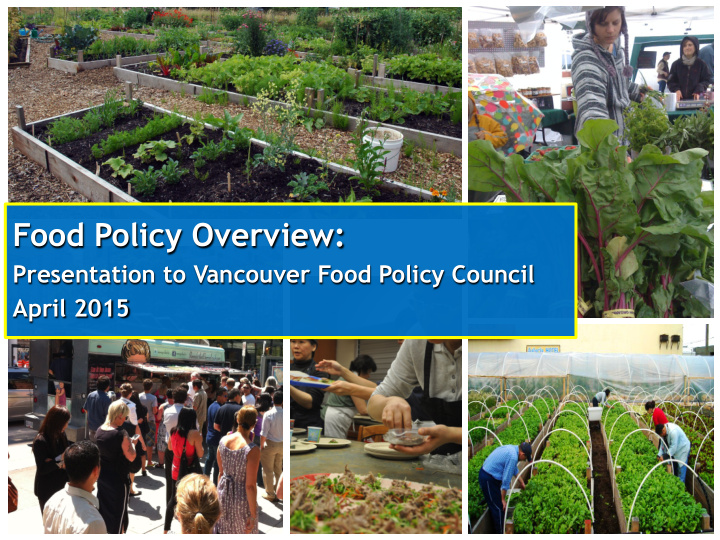



Food Policy Overview: Presentation to Vancouver Food Policy Council April 2015
Role of Local Government What local Governments Do: • Engineering Services (Street, Water, Sewers, Garbage, and Recycling) • Parks and Recreation • Police and Fire Services • Planning and Development Services • Licenses and Inspections • Libraries • Sustainability • Community Services (Housing, Culture, and Social Policy)
“Food is a tool for re-thinking cities and the way we live in them” Carolyn Steel, 2008
Food Systems Examples and Concerns Climate Change/ Greenhouse Gas Global Loss of biodiversity in food system World food prices Genetically Modified Organisms National Loss of farmland and fisheries Food labeling Food transportation Provincial Migrant workers issues Erosion of Agricultural Land Reserve Health and wellness programs Uneven food accessibility City Urban agriculture (Vancouver) Waste management Table modified from Zsuzsi Fodor, 2011
Municipal Planning Framework • Regional Growth Strategies • Agricultural Land Protection • Official Community Plans and Local Area Plans • Zoning and Land Use Regulations • Business Licenses
Broad Food Policy Context • Food Action Plan (2003) • Vancouver Food Policy Council (2004) • Food Charter (2007) • Greenest City Action Plan (2011) • Vancouver Food Strategy (2013) • Healthy City Strategy (2014)
Vancouver Food Strategy Purpose: • Integration and alignment of food policy • Provide goals and specific actions • Provide road map for action
Park Board: Local Food Action Plan Foci: • Land • Facilities • Capacity and Programs
Components of Vancouver’s Food Strategy Vision and Principles Food Charter 5 Goals Food Strategy 71 Actions
Goal 1: Create Food Friendly Goal ¡1: ¡Support ¡food-‑friendly ¡neighbourhoods ¡ Neighbourhoods Key ¡focus: ¡ ü Food ¡assets ¡/ ¡ infrastructure ¡ ü Built ¡ environment ¡ ü Scaling ¡up ¡ ü Build ¡on ¡unique ¡ context ¡of ¡each ¡ neighbourhood ¡
Goal 2: Empower residents to take action in their own neighbourhoods Key focus: ü Human capacity ü Community development ü Access to resources, skills and knowledge ü Participation and inclusion
Goal 3: Improve access to healthy, affordable, culturally diverse food for all residents Key focus: ü Vulnerable populations ü Affordability ü Healthy food options
Goal 4: Make food a centrepiece of Vancouver’s green economy Key focus: ü Localizing food supply chain ü Economic • Community garden plots continue to increase multiplier effect of local food ü Innovative models: e.g. social enterprises, food hub, food business incubator ü Green food jobs
Goal 5: Advocate for a just and sustainable food system with partners and all levels of government Key focus: ü Advocacy at all levels of government ü Partnerships ü Leverage tools
Actions contribute to all aspects of food systems
Highlights from 2014 Highlight Result • Community garden plots continue to increase • 452 plots were built on city and non-city land (total 4166) • Revised farmers market policy • 3 new farmers markets (total 11) • Fostered community food markets • Developed CFM bulletin outlining process • 5 new Curbside Fresh pilot location from Greater Vancouver Food Bank Established and secured the Sustainable Food Annual financial support to food related • • Systems Grants organizations and projects Development of food business incubator between Opening of Vancouver Incubator Kitchen • • VCC, Save on Meats ; CoV contributing $100K (VIK) at Save On Meats Incorporate food systems assets into community Sustainable Large Development Policy to • • plans and large developments require food systems plan and assets Working on urban farming policy to further Emerging urban farming policy directions • • enable commercial food production
Priorities for 2015 and beyond Highlights • Continue to increase community garden plots, while improving opportunities for capacity building, ethno- cultural representation, and infrastructure upgrades, etc • Adoption of urban farming policy to further enable commercial food production Support local food infrastructure (processing, • distribution, kitchens) • Continue to advance opportunities to increase percentage of local and sustainable food purchased by city Continue to support food related organizations and • projects through Sustainable Food Systems Grants
Recommend
More recommend